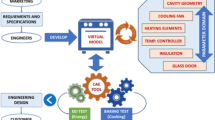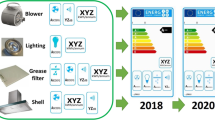Abstract
During recent years the European Ecodesign Directive has introduced big changes in the design methodology of several energy-using products including consumer goods such as ovens, washing machines and kitchen hoods. Additionally, the introduction of the Energy Labelling Directive pushes manufacturers to implement new energy-saving features in many energy-related products sold in Europe. As a consequence, several companies have been encouraging the improvement of their energy using products paying attention to the related selling cost. Eco-driven products require eco-design tools to support the eco-innovation and the related sustainability improvement. The main scope of the proposed research is the reduction of the time-to-market for the energy-using products such as kitchen hoods. In this context, the paper aims to provide an approach to support a pre-evaluation of the energy labeling related to kitchen hoods. A prototypical software tool has been developed in order to simulate the energy performance of new kitchen hood configurations in term of energy efficiency. The approach also considers the introduction of virtual experiments in order to calculate the performance of virtual modules. This tool makes the product-engineer more aware in the decision-making about the energy-saving. As a test case, different product configurations have been compared analyzing the energy labelling and the overall energy performance.
Access this chapter
Tax calculation will be finalised at checkout
Purchases are for personal use only
Preview
Unable to display preview. Download preview PDF.
Similar content being viewed by others
References
Gynther L., Mikkonen I. and Smits A. Evaluation of European energy behavioural change programmes, Energy Efficiency, 2012, 5, pp. 67–82.
Gillingham K., Newell R.G. and Palmer K. Energy Efficiency Economics and Policy, Annu. Rev. Resour. Econ., 2009, 1, pp. 597–619.
Galarraga I., González-Eguino M. and Markandya A. Willingness to pay and price elasticities of demand for energy-efficient appliances: Combining the hedonic approach and demand systems, Energy Economics, 2011, 33, pp. S66–S74.
Tyl B., Legardeur J., Millet D., Vallet F. A comparative study of ideation mechanisms used in eco-innovation tools, Journal of Engineering Design, 2014, 25 (10-12), pp 325-345.
Cluzel F., Vallet F, Tyl B, Leroy Y. Eco-design vs. eco-innovation: an industrial survey. Proceedings of the 13th International Design Conference - DESIGN 2014, 2014, pp.1501-1510.
Tyl B., Legardeur J, Millet D, Vallet F. A New Approach for the Development of a Creative Method to Stimulate Responsible Innovation”, Proceedings of the 20th CIRP Design Conference, Ecole Centrale de Nantes, Nantes, France, 19th-21st April 2010, 2011, pp 93-104.
Kock J. et al. Experimental and numerical study of a radial compressor inlet, ASME 95-GT-82, 1995.
Lee E., Feigly C. and Khan, J. An investigation of air inlet velocity in simulating the dispersion of indoor contaminants via computational fluid dynamics, Annals Occupational Hygiene, 2002, pp. 46–48.
Pitkanen H. et al. CFD analysis of a centrifugal compressor impeller and volute, ASME 99-GT-436, 1999.
Author information
Authors and Affiliations
Corresponding author
Editor information
Editors and Affiliations
Rights and permissions
Copyright information
© 2017 Springer International Publishing AG
About this chapter
Cite this chapter
Cicconi, P., Germani, M., Landi, D., Russo, A.C. (2017). A design methodology to predict the product energy efficiency through a configuration tool. In: Eynard, B., Nigrelli, V., Oliveri, S., Peris-Fajarnes, G., Rizzuti, S. (eds) Advances on Mechanics, Design Engineering and Manufacturing . Lecture Notes in Mechanical Engineering. Springer, Cham. https://doi.org/10.1007/978-3-319-45781-9_109
Download citation
DOI: https://doi.org/10.1007/978-3-319-45781-9_109
Published:
Publisher Name: Springer, Cham
Print ISBN: 978-3-319-45780-2
Online ISBN: 978-3-319-45781-9
eBook Packages: EngineeringEngineering (R0)




